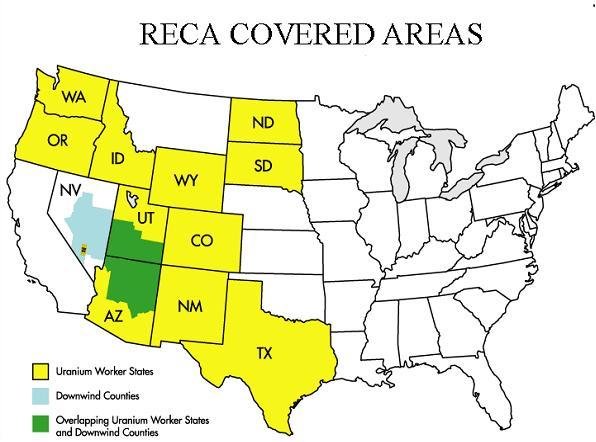Downwinder Deadlines
by Michelle Peot
Some of Toquerville’s neighbors in Leeds have recently been debating whether housing should be built over former uranium mines. A brief background and deadlines for possible radiation exposure compensation might be of interest to Toquerville residents so Michelle is sharing it here.
Nuclear testing
Between 1945 and 1962, 100 nuclear above-ground bombs were detonated by researchers at the Nevada Test Site NW of Las Vegas. One of the more insidious elements present in the nuclear fallout was the isotope iodine-131. Iodine-131 fallout was ingested by dairy cows and passed to humans through the consumption of dairy products. Once inside humans, it collects in the thyroid gland.
Iodine-131 fallout (red represents the highest concentrations)
Counties are labeled in this reference map
source: Downwinders of Utah Archive, University of Utah
Counties in northern AZ and southern UT received the greatest amount of test site fallout. Rates of cancers, including leukemia, thyroid cancer, and bone cancer in SW Utah far exceeded unexposed populations. New cases of associated cancers are still surfacing in southern Utah.
The widespread risks of nuclear testing were downplayed for decades by the federal government. It wasn't until 1979 that a federal judge in Salt Lake City first held the federal government accountable for nuclear test site fallout damages in the landmark ruling Irene Allen v. the United States, which represented 1,100 downwinders.
Uranium Mining in SW Utah
While many southwest UT residents have some awareness of the history of the Nevada atomic test fallout, many of us in Leeds were shocked to learn that our town was also home to production uranium mines. The impact of those mines continues to threaten the health of our local community. In discussing our uranium mine situation with community members, we learned that a number of downwinder families were unaware of their potential eligibility for federal compensation.
Radiation Exposure Compensation Act
In 1990 President George H.W. Bush first signed the Radiation Exposure Compensation Act (RECA) into law. The law compensated downwinders and uranium mine workers for adverse health effects of radiation and radon gas. The law has been periodically extended by bipartisan legislation, most recently in 2022. The RECA claims timeframe is currently set to expire on June 10, 2024.
Recently Senators Ben Ray Luján (NM) and Mike Crapo (ID) introduced a bipartisan bill (bill S 2798) to increase and extend RECA compensation for another two years. Our own Senator, Mike Lee, previously sponsored an extension. Given that new downstream cancer cases are still surfacing, we urge constituents to reach out to Senators Mike Lee and Mitt Romney, and Representative Chris Stewart to support RECA renewal.
Eligibility under RECA
source: Department of Justice
The following populations are eligible for health screening and potential compensation for specific health conditions:
Downwinders: people exposed to Nevada Test Site fallout during the period from 1951 to 1962
Uranium workers: workers exposed to radon exposure in uranium mines operations during the period from 1942 to 1971
Uranium mill and ore transport workers: workers who participated in uranium mill operations or ore transport during the period from 1942 to 1971
Onsite test staff: worker who participated onsite within the boundaries of the Nevada, Pacific, Trinity or South Atlantic test sites during the time of atmospheric nuclear testing by the U.S. prior to 1963
For more details on eligibility see the Health Resources Services and Administration (HRSA) website.
Health Conditions
Adverse health conditions eligible for compensation include a broad range of cancers and for uranium workers, additional obstructive lung diseases.
Health Screening
Individuals in the above exposure populations are eligible to receive health screening at an HRSA funded clinic, including Intermountain's St George Regional 400 E Campus.

